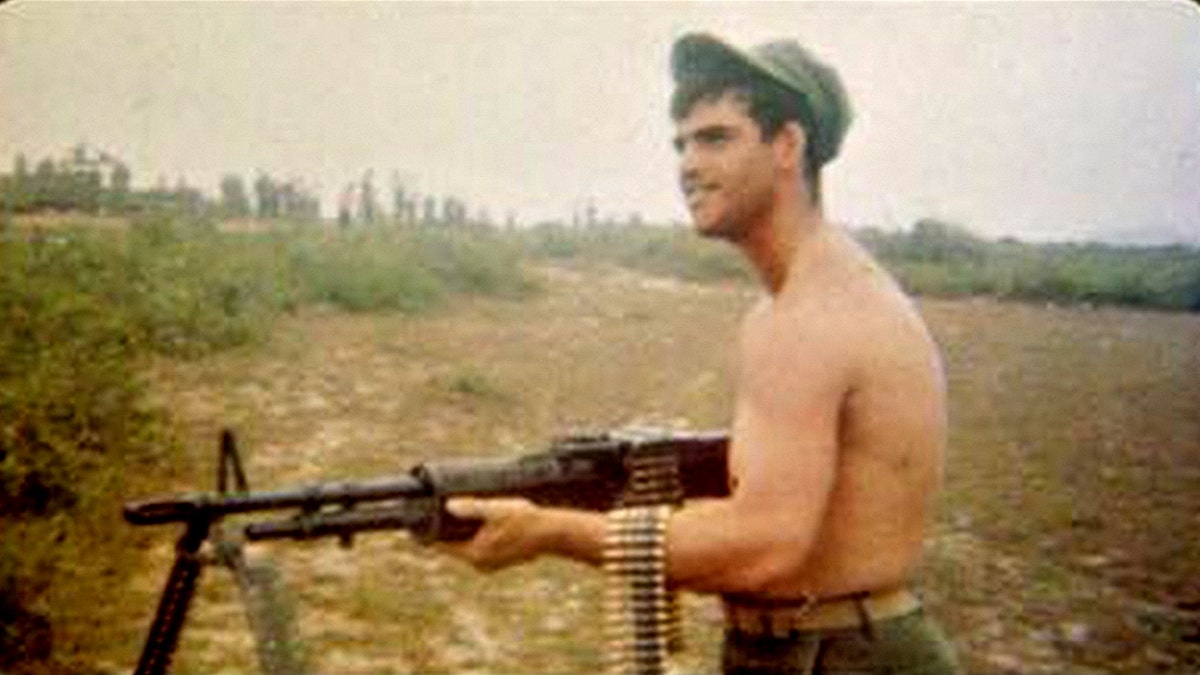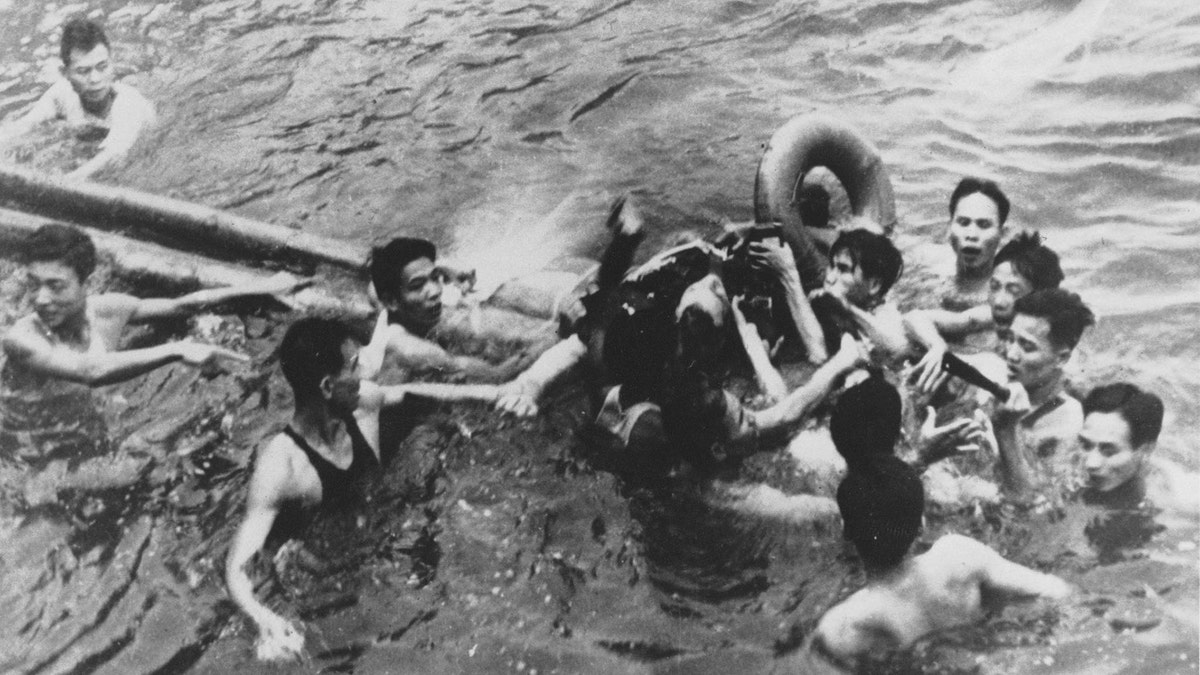True story of Vietnam War hero featured in new movie 'The Last Full Measure'
Todd Robinson, writer and director of 'The Last Full Measure,' previews the film on 'Fox & Friends.'
Get all the latest news on coronavirus and more delivered daily to your inbox. Sign up here.
President Trump has compared America’s response to the coronavirus pandemic to “a war” with “an invisible enemy.” Exactly 45 years ago – on April 30, 1975 – America lost a very different kind of war when South Vietnam fell to North Vietnamese forces. Americans and some South Vietnamese fled the capital of Saigon (now Ho Chi Minh City) in helicopters.
And just as the coronavirus has brought dramatic changes and a wave of death to our country this year, the North Vietnamese conquest did the same in South Vietnam. South Vietnamese allied with the U.S. in the long war were prime targets of the North, and so were desperate to escape the invading forces, fleeing for their lives.
South Vietnam was quite literally wiped off the map. The North and South were replaced by a united Vietnam under communist rule.
ALVIN TOWNLEY: LESSONS ON ENDURING CORONAVIRUS CRISIS FROM THESE HEROES OF VIETNAM
Many Americans fought heroically in the Vietnam War, and the fact that the U.S. lost the long conflict does nothing to diminish their valor and patriotism. The war claimed the lives of more than 58,000 brave Americans.
One of the American heroes of the Vietnam War was Master Gunnery Sgt. Juan Valdez of Oceanside, Calif., who was one of the first U.S Marines to arrive in Vietnam. When he was pulled into a helicopter lifting off from the roof of the U.S. Embassy exactly 45 years ago, he was one of the last to leave.
Valdez’s departure marked the end of U.S. involvement in Vietnam that began when President Dwight Eisenhower sent military advisers to train the South Vietnamese Army in 1955.
The U.S. presence grew under President John F. Kennedy and then expanded dramatically under President Lyndon Johnson.
More from Opinion
In Vietnam and neighboring Southeast Asian nations, the Cold War turned into a hot war – a bloody struggle between the forces of communism and those who were committed to keeping the world free.
At the height of our involvement in the Vietnam War in 1968, almost 544,000 U.S. troops were stationed in the country. Over the entire course of the war 3.4 million Americans served in the Southeast Asia theater that was involved in the war, including in Laos, Cambodia, the South China Sea and Thailand in addition to South Vietnam.
LOUISE HARRIS: THEY SAID MY HUSBAND VANISHED IN VIETNAM — BUT I KNEW HE WAS ALIVE
In early 1973, after years of dogged negotiations in Paris, President Richard Nixon secured an agreement with the North Vietnamese that called for a cease-fire between the North and the South, the withdrawal of American troops, and the return of American prisoners of war.
However, despite Nixon’s assurances to the South Vietnamese that any further aggression from the North would be met with a “full force” response by the United States, the agreement was rife with ambiguities.
As Nixon withdrew U.S. troops, he left the South Vietnamese well-armed and supplied. However, after Nixon’s August 1974 resignation as a result of the Watergate scandal – and an antiwar movement that staged massive protests in the U.S. – the government in Saigon was left helpless and without U.S. support.
On March 10, 1975, the North Vietnamese Army marched south in a final assault on South Vietnam.
Despite the heroic efforts of the South Vietnamese, cities such as Hue and Da Nang soon fell to North Vietnamese forces, leading to the capture and execution of thousands of civil servants, schoolteachers, and other members of the country’s middle class.
As the South Vietnamese Army disintegrated, over a half-million refugees fled south towards Saigon where there were only about 6,000 Americans left. Over 200,000 South Vietnamese and their families who had worked with or supported U.S. forces were in the city.
In an April 10 address to a joint session of Congress, President Gerald Ford made a desperate request for $722 million in emergency aid for South Vietnam. Congress refused any support. South Vietnam’s fate was sealed.
U.S. Ambassador to South Vietnam Graham Martin, a resolute anti-communist who had lost his only son in the war, refused to recognize the danger posed by North Vietnamese forces on Saigon.
Despite news reports and the pleas of his advisers, Martin believed the South could still defend its independence. Some on his staff, however, realized the end was near and quietly defied him and surreptitiously organized the evacuation of senior South Vietnamese military officers, their families and other civilians.
By mid-April, North Vietnamese troops were on the outskirts of Saigon and by month’s end, their rockets were landing in the heart of Saigon, signaling a ground attack from five directions on the city.
Pandemonium ensued. Thousands of terrified South Vietnamese civilians rushed to the safety of the Americans, with more than 60,000 rescued at sea, while thousands of others drowned.
As the bombs fell on the South Vietnamese capital, Martin finally ordered U.S. embassy personnel to begin evacuating all Americans from Saigon.
As we remember the fall of Saigon on this anniversary, let us remember all those who paid the heaviest price for freedom.
Just after 11 a.m. on April 29, a special message was broadcast on Saigon radio – “the temperature in Saigon is 105 degrees and rising” – followed by a recording of Tennessee Ernie Ford singing White Christmas that signaled the evacuation was to begin by helicopter from designated locations around Saigon.
More than 10,000 South Vietnamese surrounded the U.S. Embassy seeking sanctuary. Despite strict orders from Washington to only evacuate Americans, Martin instructed staff to evacuate as many South Vietnamese as possible.
Knowing that once the Americans were gone the evacuation would cease, Martin placed only one or two Americans on each helicopter. The remaining space on the massive C-46 helicopters were packed with 60 to 75 escaping South Vietnamese each time one took off from the Embassy's roof or courtyard.

Marine Lance Corporal Jimmy Reddington was killed in Vietnam in 1967.
More than 75 helicopters crisscrossed the sky for over 18 exhausting hours ferrying fleeing Americans and South Vietnamese from Saigon to U.S. ships off South Vietnam’s coast.
At the same time, many South Vietnamese military pilots commandeered helicopters to carry their families to American ships including the U.S.S. Kirk commanded by Navy Capt. Paul Jacobs, who made the fateful decision to allow 17 South Vietnamese helicopters to land on his ship’s deck, one at a time.
Because of a lack of space on the ship’s deck, each of the helicopters was ditched at sea. The Kirk’s crew members used their own money to buy food, candy and clothes from the ship’s commissary for the families huddled on board. Jacobs’ brave actions saved 157 Vietnamese men, women and children.
At the U.S. Embassy, Gunnery Sgt. Valdez desperately tried to manage the frantic crowd of South Vietnamese while other Embassy personnel were incinerating cash and mountains of classified documents – many of which named South Vietnamese friends and supporters of the American effort in the country.
Most documents were not destroyed, however and those that were shredded were subsequently taped together by the North Vietnamese and used as justification for mass executions of South Vietnamese who were deemed collaborators.
At 4 a.m. on April 30, Martin was ordered by the White House to leave the Embassy – with Marine Capt. Gerald Berry, himself exhausted from numerous flights, ordered to force Martin to go if he refused.

John McCain is pulled out of a Hanoi lake by a mix of North Vietnamese Army (NVA) and Vietnamese citizens in this October, 1967 file photo. McCain was shot down by a Surface-to-Air Missile (SAM) and had broken both arms and his right knee upon ejection, losing consciousness,
As North Vietnamese tanks approached, the Marines lowered the U.S. flag, handed it to Martin and he was flown out to sea.
“This will be the final message from Saigon station,” CIA Chief Thomas Polgar wired to Washington. “It has been a long fight and we have lost. Those who fail to learn from history are forced to repeat it. Let us hope that we will not have another Vietnam experience and that we have learned our lesson. Saigon signing off.”
Eleven Marines under Valdez’s command remained on the Embassy roof despite the mistaken belief in Washington that all U.S. personnel had been evacuated. The desperate Marines radioed out a distress call for hours that went unacknowledged.
But just as they had determined they’d fight it out with their sidearms, a helicopter appeared on the horizon. At 7:53 a.m. the last helicopter lifted off the Embassy roof.
The valiant Valdez was nearly left behind, having stumbled and fallen as the C-46 ramp closed. Only after Staff Sgt. Mike Sullivan conducted a headcount and, finding they were one Marine short, was the ramp lowered so that Valdez could be pulled aboard, making him the last U.S. serviceman to leave Vietnam.
The helicopter evacuation of Saigon – “Operation Frequent Wind” – was the largest such evacuation in history. Nearly 7,000 U.S. Embassy staff, foreign nationals and South Vietnamese civilians were flown to safety.
CLICK HERE TO SIGN UP FOR OUR OPINION NEWSLETTER
Together with the sea evacuation, over 130,000 South Vietnamese escaped the oncoming North Vietnamese forces. However, tens of thousands of South Vietnamese – including thousands of children fathered by American servicemen and 420 civilians in the Embassy courtyard who had been promised rescue by Embassy staff – were abandoned to their fate.
By the end of that fateful day 45 years ago, South Vietnam fell, setting the stage for a prolonged period of losses by the forces of freedom in the Cold War. That changed, however, beginning in 1980 with the election of Ronald Reagan and ending with the fall of the Berlin Wall nine years later.
But no one should forget the tremendous cost in blood and liberty paid by so many throughout the struggle against tyranny in the Vietnam War.
CLICK HERE TO GET THE FOX NEWS APP
The last two American service members killed by enemy fire in the Vietnam War were Marines. Cpl. Charles McMahon Jr. of Woburn, Mass., who was only 21. Lance Cpl. Darwin Judge of Marshalltown, Iowa, who was only 19. They lost their lives in the final North Vietnamese artillery attack on Saigon before dawn April 29.
As we remember the fall of Saigon on this anniversary, let us remember all those who paid the heaviest price for freedom.

